DayStar Index
![]() Distribution
Distribution
![]() News
News ![]() Notes & Interesting Articles
Notes & Interesting Articles
![]() Pricing
Pricing
![]()
![]() Warranty
Warranty


Right: Sunspot through DayStar ATM 0.5Å bandpass filter; another simply stunning image by Dave Tyler courtesy of DayStar Filters, LLC (79,972 bytes).
In that all interference filtering devices are sensitive to temperature changes, all DayStar University and ATM filters were designed to operate on band at a temperature above the expected ambient conditions; this nominal operating temperature is typically between 40 and 50 degrees Celsius. To reach the nominal operating temperature it is necessary to install the University and ATM filter system elements into a compact, cylindrical temperature regulated oven. The oven is fabricated for operation in either 115 volt or 220 volt AC current. The oven is regulated by a ten turn knob pot. By controlling the current flow to the oven element models can be calibrated with settings provided with each new filter produced*. This ability to vary the current also permits those models with calibrated off-band tuning and signal optimization to shift the passband by 1.0Å per 16.8 degrees F; therefore, increase the temperature for long side shifts, decrease for short side shift. And by varying the etalon temperature the observer is able to optimize contrast and engage in Doppler studies. These precision systems are extremely difficult to produce, and may create a variable delivery schedule.
*Use of a dielectic coated mirror diagonal such as our Astro-Physics "Maxbright", or TeleVue "Everbrite" with heated accessories such as the DayStar University and ATM series Hydrogen-Alpha Filters will necessitate an increase of the filter operating temperature setting because the coatings of these diagonals do block infrared energy.
2. ATM series filtering systems appear similar to the University series but lack their uniformity, regardless of that for most users the ATM series provides wonderful visual and imaging fidelity at an affordable cost. Smooth spectral uniformity offered by instrument quality etalons satisfy the needs of most observers. Informative filtergrams can be made with slight dodging in the darkroom. Nominal at f/32, (full aperture or stopped down) with optical systems delivering an effective focal length of up to 2000mm the user will find the spectral uniformity of these filters impressive. The ATM series were available in a bandpass range of from 0.95Å to 0.50Å. The ATM series incorporate a cylindrical temperature regulated oven similar to that provided with the University series filters. If the main stay of the observing program concentrates on filtergrams and CCD imaging, then we suggested clients consider the advantages of the University (now improved with the QUANTUM PE) series filter. If the main desire is for visual work and taking basic filtergrams, these could be an excellent choice. During the course of manufacturing a filtering unit, each is thermally tuned by a precision factory-calibrated oven to maintain proper bandpass tuning. We continue to be amazed by images and views delivered by these systems.
Right: DayStar T-Scanner 0.50Å bandpass Hydrogen Alpha filter at Company Seven. This is the body with no attachment fittings installed.
T-Scanner filters were fabricated to the same transmission quality and safety standards as most of the University and ATM series. These filters were intended for visual and casual imaging work and were available in a choice of between 0.80Å to 0.50Å bandpass. The filters utilize an aperture of up to 31.7 mm and operate in a nominal f/32 optical system. Because of the internal tilting mechanism they are made to operate within a nominal range of about 40 degrees F, in environments of cold or heat outside their nominal range the filter may not be able to get exactly on the designed band. So we would typically spec them for 70 degree F climates, this allowed good performance spanning from 50 to 90 degrees F. Note modern filters that rely on tilting or pressure changes to center their bandpass for tuning can have similar limitations.
These older existing T-scanner filters too may be upgraded to the new ION body style.
Left: The Sun as it may appear through a White Light Filter (32,724 bytes).
Depending on the nature of the coating or metal used to make the filter the Sun may appear white, blue, yellow (as shown at left), or orange red. The features visible in a white light filter may include: 1. dark sunspots, 2. the bright faculae, and 3. granules. One can also measure the flow of material in the photosphere using the Doppler effect. These measurements reveal additional features such as supergranules as well as large scale flows and a pattern of waves and oscillations.
DayStar Filter™ Discontinued Filter Products - For Information Only
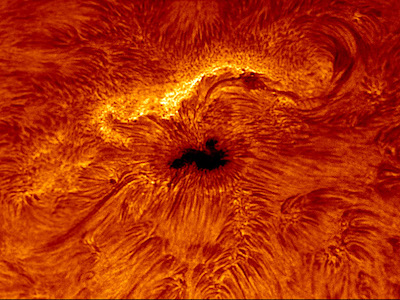 We at Company Seven have decided to equip our facility to study the Sun with our Astro-Physics and our TeleVue refracting telescopes of up to 206mm aperture! Although for reasons of convenience and because of the typical limits imposed by our local "seeing" conditions, we routinely employ telescopes of only between 80mm to 130mm. Depending on your requirements and local seeing conditions, you may employ smaller or much larger, even meter class telescopes. We invite you to contact Company Seven to learn more about these systems, or visit our showroom to see the DayStar filters in operation.
We at Company Seven have decided to equip our facility to study the Sun with our Astro-Physics and our TeleVue refracting telescopes of up to 206mm aperture! Although for reasons of convenience and because of the typical limits imposed by our local "seeing" conditions, we routinely employ telescopes of only between 80mm to 130mm. Depending on your requirements and local seeing conditions, you may employ smaller or much larger, even meter class telescopes. We invite you to contact Company Seven to learn more about these systems, or visit our showroom to see the DayStar filters in operation.
Click on image to see enlarged view (222,751 bytes).
![]() The now discontinued models of Hydrogen-Alpha filters that were in production by DayStar between 1975 through 2006 can be upgraded to modern QUANTUM PE, QUANTUM SE, or ION configurations. These older filter models were:
The now discontinued models of Hydrogen-Alpha filters that were in production by DayStar between 1975 through 2006 can be upgraded to modern QUANTUM PE, QUANTUM SE, or ION configurations. These older filter models were:
1. University series filtering systems represented the finest components manufactured by DayStar Filter Co. in Chino, California through 2005. Professional institutions and advanced observers that employ research quality optical systems considered these the top quality product of their class with highly uniform transmission across the entire optical plane. University models were available with a bandpass as wide as 0.80Å or as narrow as 0.40Å, The University series is designed to handle any focal length system providing a nominal f/32 beam while delivering full aperture spectral uniformity; the resulting visual observations, CCD images and traditional filtergrams are simply stunning.
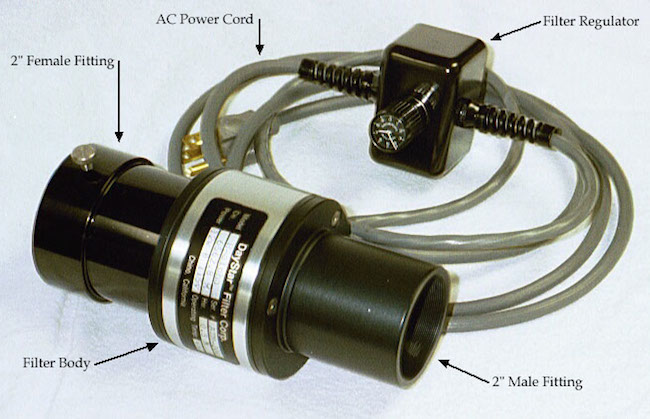
Above: DayStar Oven Model Filter; this is the arrangement typical of the University, ATM, and Calcium K-Line series filters.
Energy Rejection Pre Filter not shown here (67,772 bytes).
![]()
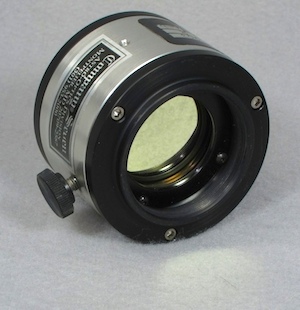 3. T-Scanner series filter assemblies were designed for amateur observers doing remote observations or without ready access to AC power. By taking advantage of fundamental physics relating to thin film coatings the ATM models employ an alternative method of tuning other than controlling the etalon's temperature. The tuning is achieved by tilting the enclosed filtering assembly. Tilting the filtering components causes the light path to increase the distance traveled through the elements or decrease that distance depending on the angle of incidence; this shifts the bandpass towards or away from the shorter wavelengths. By fabricating the filter a few angstroms longer than the desired observing wavelength, the observer can optimize the contrast simply by tilting the filtering system with a control screw knob.
3. T-Scanner series filter assemblies were designed for amateur observers doing remote observations or without ready access to AC power. By taking advantage of fundamental physics relating to thin film coatings the ATM models employ an alternative method of tuning other than controlling the etalon's temperature. The tuning is achieved by tilting the enclosed filtering assembly. Tilting the filtering components causes the light path to increase the distance traveled through the elements or decrease that distance depending on the angle of incidence; this shifts the bandpass towards or away from the shorter wavelengths. By fabricating the filter a few angstroms longer than the desired observing wavelength, the observer can optimize the contrast simply by tilting the filtering system with a control screw knob.
The filter is distinguished at first glance by the tilt control knob at the side, and by the lack of any AC power cord (32,724 bytes).
![]() DayStar Hydrogen Alpha Filters
DayStar Hydrogen Alpha Filters
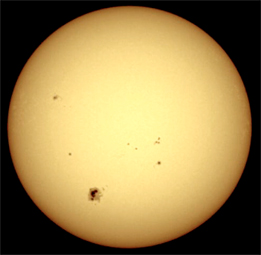 The photosphere is the visible surface of the Sun that amateur astronomers are most familiar with. this is readily observed with relatively inexpensive solar filters such as that we offer by Questar, and Baader Planetarium for example. The visible surface of the Sun is not a solid surface but is actually a layer of the gas ball that is about 100 km thick; this is relatively thin compared to the 700,000 km radius of the Sun. When observing the center of the disk of the Sun we look straight in and see somewhat hotter and brighter regions. When one observes the limb of the solar disk that light has taken a slanting path through this layer and we only see through the upper, cooler and dimmer regions. This explains the "limb darkening" that appears as a darkening of the solar disk near the limb. A number of features can be observed in the photosphere with a simple telescope equipped with a suitable "White Light" filter with a metal coated glass or polymer element, designed to reduce the intensity of the Sun light to comfortable levels, and to eliminate or attenuate harmful portions of the spectrum.
The photosphere is the visible surface of the Sun that amateur astronomers are most familiar with. this is readily observed with relatively inexpensive solar filters such as that we offer by Questar, and Baader Planetarium for example. The visible surface of the Sun is not a solid surface but is actually a layer of the gas ball that is about 100 km thick; this is relatively thin compared to the 700,000 km radius of the Sun. When observing the center of the disk of the Sun we look straight in and see somewhat hotter and brighter regions. When one observes the limb of the solar disk that light has taken a slanting path through this layer and we only see through the upper, cooler and dimmer regions. This explains the "limb darkening" that appears as a darkening of the solar disk near the limb. A number of features can be observed in the photosphere with a simple telescope equipped with a suitable "White Light" filter with a metal coated glass or polymer element, designed to reduce the intensity of the Sun light to comfortable levels, and to eliminate or attenuate harmful portions of the spectrum.
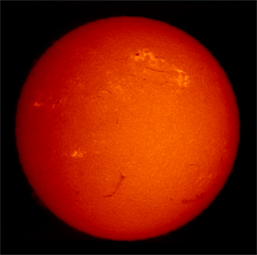 The chromosphere appears as "peach fuzz" surrounding the Sun; this is an irregular layer above the Sun's photosphere where the temperature rises rapidly from 6000°C to about 20,000°C. At these higher temperatures the hydrogen emits light that gives off a deep red color (H-alpha emission, often abbreviated as HÅ). The chromosphere derives its name (color-sphere) from this phenomena. This colorful emission can also be seen in prominences that erupt and then project to beyond the limb of the Sun into the blackness of space. Prominences may be safely observed by the naked eye during total solar eclipses.
The chromosphere appears as "peach fuzz" surrounding the Sun; this is an irregular layer above the Sun's photosphere where the temperature rises rapidly from 6000°C to about 20,000°C. At these higher temperatures the hydrogen emits light that gives off a deep red color (H-alpha emission, often abbreviated as HÅ). The chromosphere derives its name (color-sphere) from this phenomena. This colorful emission can also be seen in prominences that erupt and then project to beyond the limb of the Sun into the blackness of space. Prominences may be safely observed by the naked eye during total solar eclipses.
Left: The Sun as it may appear through a Daystar Hydrogen Alpha Filter (37,053 bytes).
However, when the Sun is studied through a spectrograph or a filter that is engineered to isolate the H-alpha emission, then many more features are revealed including: the chromospheric network of magnetic field elements, bright plage around sunspots, dark filaments across the disk, and prominences beyond the limb.
The most commonly used portion of the spectrum for serious studies of the Sun work is in the red portion of the solar spectrum, at the line of Hydrogen Alpha (sometimes written as Hydrogen-α) located at 6562.81Å. At its half intensity point, this line is only 1.20Å wide. A 0.5Å bandpass filter is passing only about 1/8000 of the frequency band of visible light! Providing optical filtration in this order of dimension is most demanding, and DayStar is among the few who have been able to do this consistently, and with good durability and longevity of the filter system.
Our DayStar Hydrogen Alpha filter product line currently consists of three series of filters which obviously will differ one from another by modes of tuning, by bandpass, and by spectral uniformity. In making a filter selection, one should focus on technical considerations including the desired performance requirements in terms of spectral uniformity, and filter bandpass*1.
- *1 The segment of the solar spectrum transmitted.
-
*2 An extremely flat and parallel crystalline substrate.
All DayStar Hydrogen Alpha filters provide clear and exciting images of prominence and surface phenomena, to see these and read an explanation of them refer to DayStar DayStar Bandpass Filters: An Introduction To What They Show And Why in our DayStar Library section. Observers concentrating on prominence work generally prefer a wider bandpass, (0.95 to 0.80Å). Those concentrating on subtle surface detail require higher contrast or ultra-narrow bandpass filter systems, (0.70 to 0.50Å); the most common fabrication request from the amateur who is venturing into this area for the first time is 0.60Å for example.
A visual representation of the differences observed with Hydrogen Alpha filters of different bandpass:
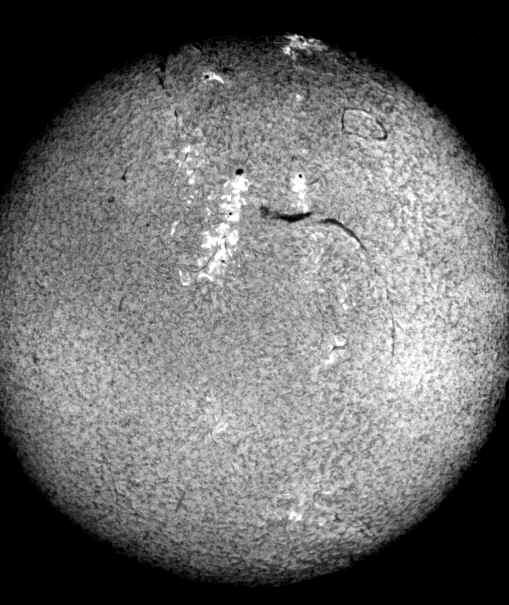
|
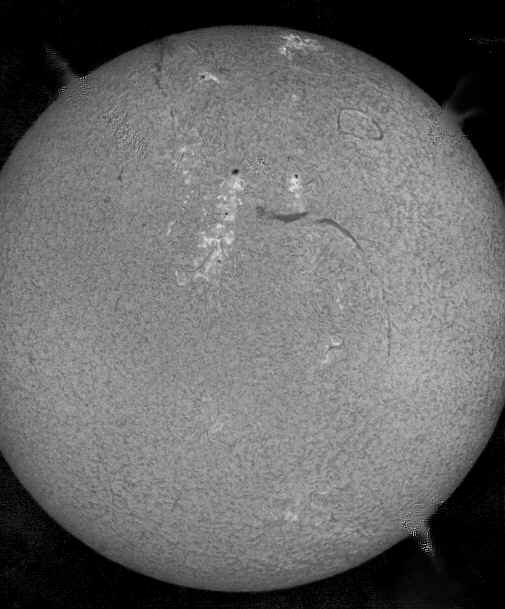
|

|
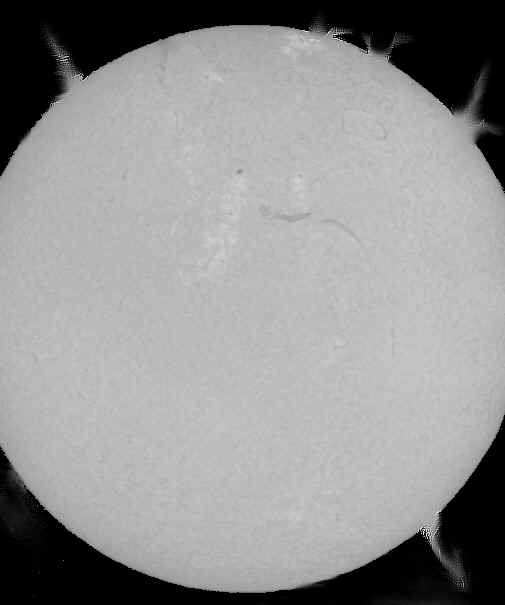
|
So basically speaking, the narrower the bandpass is then the more striking will be surface features but with some loss in the ability to observe large prominences particularly as they extend and cool farther and farther away from the Sun. The wider the bandpass is then the finer surface will be less apparent even though Sunspots remain visible, but the larger prominences and Coronal Mass Ejections that extend far off the limb of the Sun are more apparent.
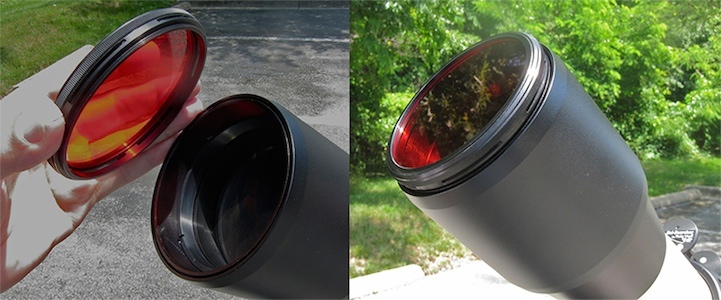 Energy Rejection Prefilter: the DayStar Hydrogen Alpha solar filters are engineered to function with an optional energy reduction "pre filter" attached onto the front of almost any telescope. This can be employed with or without an aperture stop. While the cylindrical housing of the filter body is installed onto the focuser of the telescope.
Energy Rejection Prefilter: the DayStar Hydrogen Alpha solar filters are engineered to function with an optional energy reduction "pre filter" attached onto the front of almost any telescope. This can be employed with or without an aperture stop. While the cylindrical housing of the filter body is installed onto the focuser of the telescope.
This is an optional precisely made glass filter element housed in a machined aluminum cell that is attached over the objective of a telescope, well ahead of the Hydrogen Alpha filter assembly. It's primary function is to reduce the intensity of portions of the solar spectrum which could otherwise result in damage to the Hydrogen Alpha filter elements. This component may be calculated to shape the beam of light towards a nominal focal ratio by reducing aperture of the telescope for example. So the Prefilter element may be made to cover the entire front opening of the telescope, this being referred to as a full aperture configuration. Or the Prefilter cell can be made to cover the perimeter of the telescope objective holding a smaller diameter filter glass to suit the requirements of the optical arrangement. The Prefilter can be made as an off-axis arrangement (for obstructed telescopes) or centered on-axis for use on unobstructed telescopes, refractors for example. One or more aperture stops can be used stop down the Prefilter to suit seeing conditions, or reduce the brightness of the image to suit camera limitations or for some special effect.
Right: precision Prefilter manufactured by Company Seven for use with a DayStar Hydrogen Alpha filter. At left it is shown hand held, and at right installed (111,301 bytes).
The proper design involving selection of the Prefilter aperture, proper qualities of the filter glass element in terms of raw material homogeneity and freedom from striae, and excellence of manufacturing (flatness and smoothness of surfaces and parallelism of the two optical flat surfaces) are essential to the proper operation of any DayStar Hydrogen Alpha filter. Operation of a DayStar hydrogen alpha filter without this component is not practical and will void the warranty.
For a complete review of the system components, and how they function then read the instruction manual that was written by Company Seven and that is provided by us with each controller that is sold by us.
Contents Copyright 1994-2014 Company Seven - All Rights Reserved

